Abstract
1. The effect of inducing drug therapy on the relationship between in vitro (cytochrome P-450 content) and in vivo (antipyrine kinetics) was investigated by comparing eleven consecutively treated epileptics with two groups of controls, eleven subjects with normal liver histology and eleven disease matched non-epileptics, all underwent diagnostice liver biopsy. 2. The epileptics had significantly higher cytochrom P-450 level in biopsies and they also metabolized antipyrine faster than the controls. 3. Decrease in antipyrine half-life in epileptics was related with alterations in liver histology, whereas the level of cytochrome P-450 was not. 4. There was a linear relationship between these two indices of enzyme induction when regressed on logarithmic data.
Full text
PDF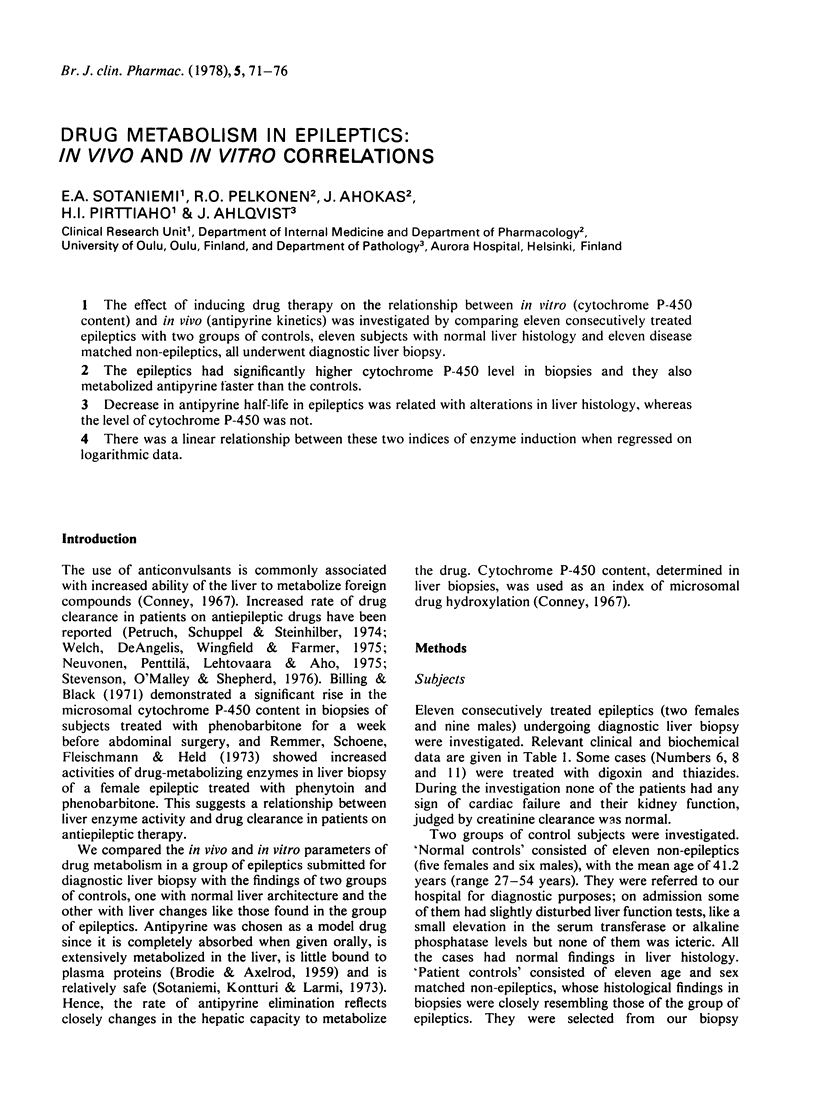

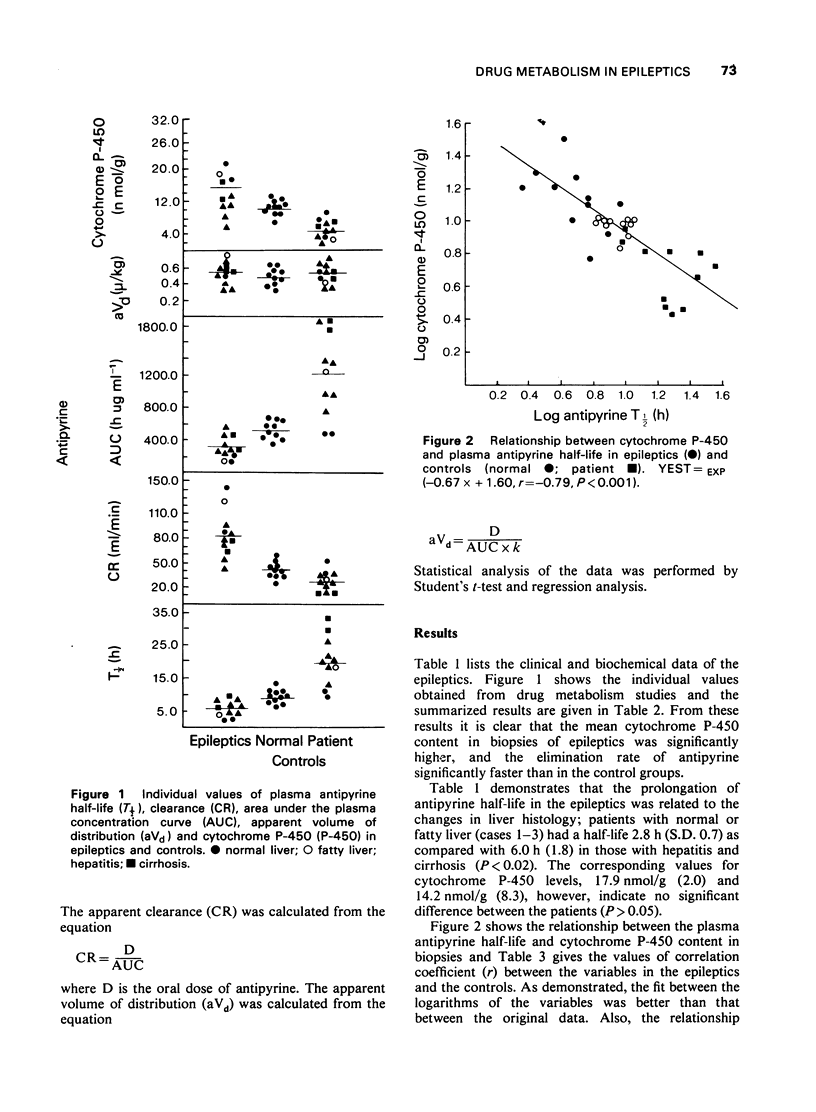
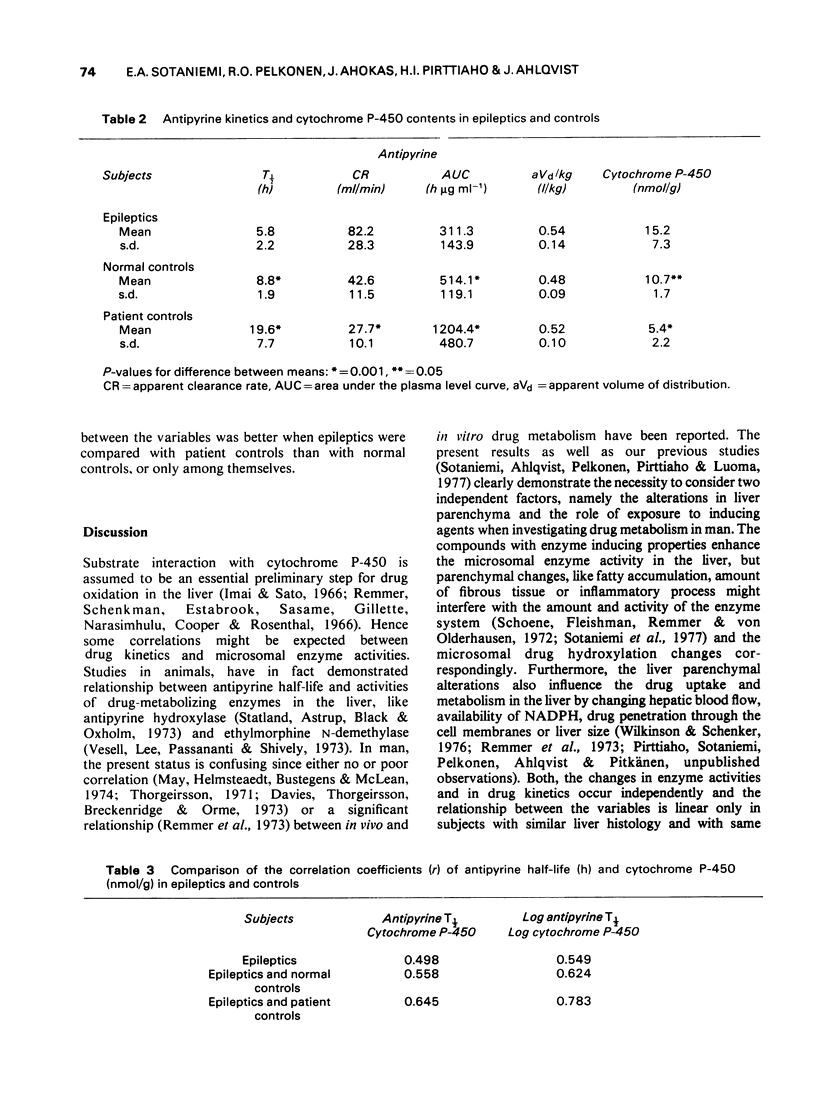
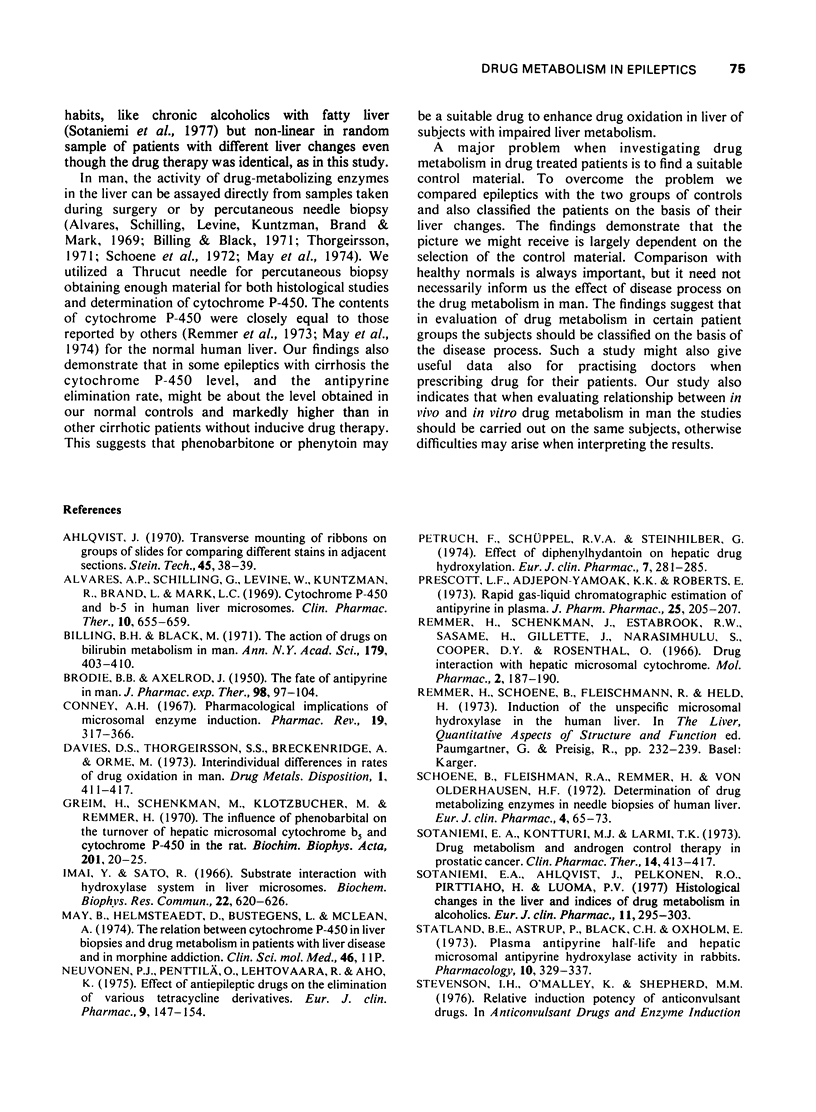
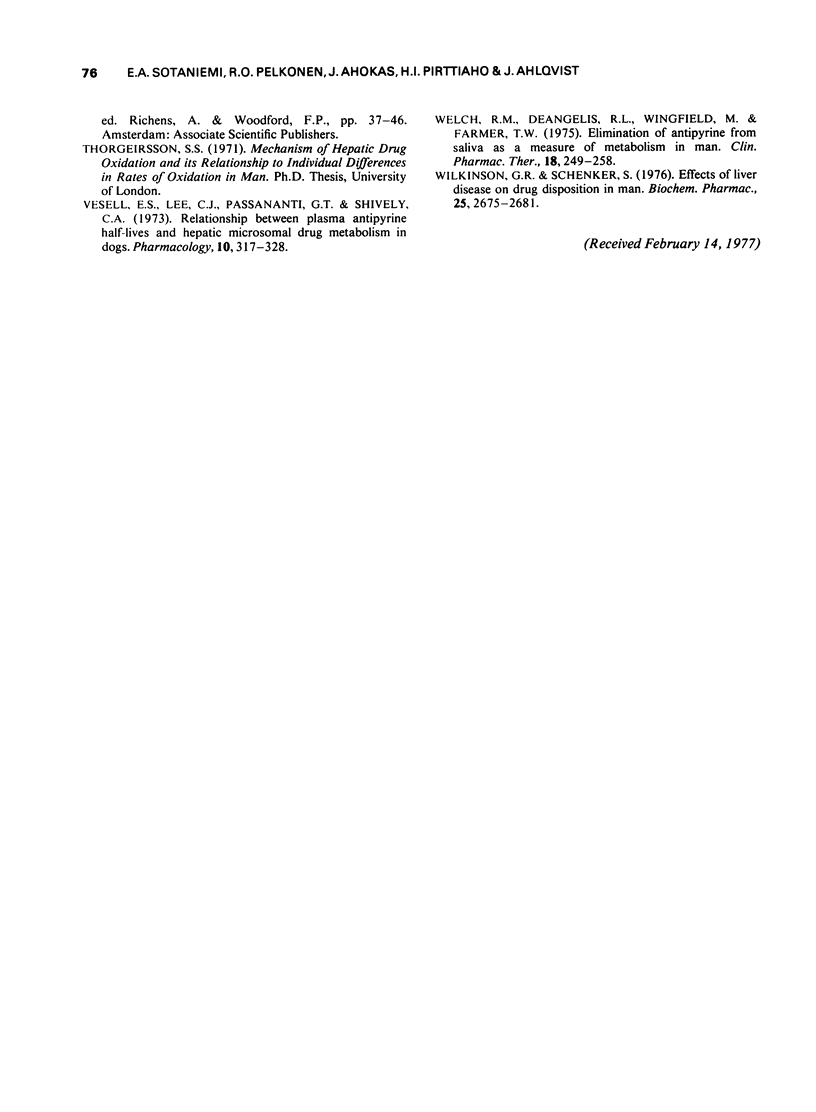
Selected References
These references are in PubMed. This may not be the complete list of references from this article.
- Ahlqvist J. Transverse mounting of ribbons on groups of slides for comparing different stains in adjacent sections. Stain Technol. 1970 Jan;45(1):38–39. [PubMed] [Google Scholar]
- Alvares A. P., Schilling G., Levin W., Kuntzman R., Brand L., Mark L. C. Cytochromes P-450 and b5 in human liver microsomes. Clin Pharmacol Ther. 1969 Sep-Oct;10(5):655–659. doi: 10.1002/cpt1969105655. [DOI] [PubMed] [Google Scholar]
- BRODIE B. B., AXELROD J. The fate of antipyrine in man. J Pharmacol Exp Ther. 1950 Jan;98(1):97–104. [PubMed] [Google Scholar]
- Billng B. H., Black M. The action of drugs on bilirubin metabolism in man. Ann N Y Acad Sci. 1971 Jul 6;179:403–410. doi: 10.1111/j.1749-6632.1971.tb46917.x. [DOI] [PubMed] [Google Scholar]
- Conney A. H. Pharmacological implications of microsomal enzyme induction. Pharmacol Rev. 1967 Sep;19(3):317–366. [PubMed] [Google Scholar]
- Davies D. S., Thorgeirsson S. S., Breckenridge A., Orme M. Interindividual differences in rates of drug oxidation in man. Drug Metab Dispos. 1973 Jan-Feb;1(1):411–417. [PubMed] [Google Scholar]
- Greim H., Schenkman J. B., Klotzbücher M., Remmer H. The influence of phenobarbital on the turnover of hepatic microsomal cytochrome b5 and cytochrome P-450 hemes in the rat. Biochim Biophys Acta. 1970 Jan 27;201(1):20–25. doi: 10.1016/0304-4165(70)90005-x. [DOI] [PubMed] [Google Scholar]
- Imai Y., Sato R. Substrate interaction with hydroxylase system in liver microsomes. Biochem Biophys Res Commun. 1966 Mar 22;22(6):620–626. doi: 10.1016/0006-291x(66)90191-4. [DOI] [PubMed] [Google Scholar]
- Neuvonen P. J., Penttilä O., Lehtovaara R., Aho K. Effect of antiepileptic drugs on the elimination of various tetracycline derivatives. Eur J Clin Pharmacol. 1975 Dec 19;9(2-3):147–154. doi: 10.1007/BF00614011. [DOI] [PubMed] [Google Scholar]
- Petruch F., Schüppel R. V., Steinhilber G. Effect of diphenylhydantoin on hepatic drug hydroxylation. Eur J Clin Pharmacol. 1974 Jul 26;7(4):281–285. doi: 10.1007/BF00560345. [DOI] [PubMed] [Google Scholar]
- Prescott L. F., Adjepon-Yamoah K. K., Roberts E. Rapid gas-liquid chromatographic estimation of antipyrine in plasma. J Pharm Pharmacol. 1973 Mar;25(3):205–207. doi: 10.1111/j.2042-7158.1973.tb10625.x. [DOI] [PubMed] [Google Scholar]
- Remmer H., Schenkman J., Estabrook R. W., Sasame H., Gillette J., Narasimhulu S., Cooper D. Y., Rosenthal O. Drug interaction with hepatic microsomal cytochrome. Mol Pharmacol. 1966 Mar;2(2):187–190. [PubMed] [Google Scholar]
- Schoene B., Fleischmann R. A., Remmer H., von Oldershausen H. F. Determination of drug metabolizing enzymes in needle biopsies of human liver. Eur J Clin Pharmacol. 1972 Mar;4(2):65–73. doi: 10.1007/BF00562499. [DOI] [PubMed] [Google Scholar]
- Sotaniemi E. A., Ahlqvist J., Pelkonen R. O., Pirttiaho H., Luoma P. V. Histological changes in the liver and indices of drug metabolism in alcoholics. Eur J Clin Pharmacol. 1977 Apr 20;11(4):295–303. doi: 10.1007/BF00607680. [DOI] [PubMed] [Google Scholar]
- Sotaniemi E. A., Kontturi M. J., Larmi T. K. Drug metabolism and androgen control therapy in prostatic cancer. Clin Pharmacol Ther. 1973 May-Jun;14(3):413–417. doi: 10.1002/cpt1973143413. [DOI] [PubMed] [Google Scholar]
- Statland B. E., Astrup P., Black C. H., Oxholm E. Plasma antipyrine half-life and hepatic microsomal antipyrine hydroxylase activity in rabbits. Pharmacology. 1973;10(6):329–337. doi: 10.1159/000136454. [DOI] [PubMed] [Google Scholar]
- Vesell E. S., Lee C. J., Passananti G. T., Shively C. A. Relationship between plasma antipyrine half-lives and hepatic microsomal drug metabolism in dogs. Pharmacology. 1973;10(6):317–328. doi: 10.1159/000136453. [DOI] [PubMed] [Google Scholar]
- Welch R. M., DeAngelis R. L., Wingfield M., Farmer T. W. Elimination of antipyrine from saliva as a measure of metabolism in man. Clin Pharmacol Ther. 1975 Sep;18(3):249–258. doi: 10.1002/cpt1975183249. [DOI] [PubMed] [Google Scholar]
- Wilkinson G. R., Schenker S. Effects of liver disease on drug disposition in man. Biochem Pharmacol. 1976 Dec 15;25(24):2675–2681. doi: 10.1016/0006-2952(76)90256-2. [DOI] [PubMed] [Google Scholar]


